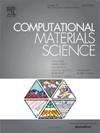Simulating trapping sites with accelerated random diffusion methods
IF 3.3
3区 材料科学
Q2 MATERIALS SCIENCE, MULTIDISCIPLINARY
引用次数: 0
Abstract
Many structural evolution is governed by diffusion of atoms. If the diffusion is random, accelerated kinetic Monte Carlo methods based on random-walk statistics can be used to model the structural evolution on 10 + year / μm scales. However, diffusion in practical materials is usually not random due to the presence of various trapping defects such as vacancies, impurity / alloy solutes, dislocations, and grain boundaries. If these defects are modeled with the conventional kinetic Monte Carlo methods, the computation efficiency can easily drop by more than 10 orders of magnitude. In this work, we show that the trapping energy of any trapping site can be arbitrarily modified without changing the trapping thermodynamics provided that we can modify the entropy of the trapping site to recover its trapping Gibbs free energy. Since we can set the trapping energy of trapping sites to zero, random-walk statistics can still be applied to incorporate trapping defects. Our new method will enable future accelerated kinetic Monte Carlo methods to be developed to simulate the evolution of realistic microstructures on 10 + year / μm scales.
用加速随机扩散方法模拟捕获点
许多结构的演化是由原子的扩散控制的。如果扩散是随机的,基于随机游走统计的加速动力学蒙特卡罗方法可以在10 +年/ μm尺度上模拟结构演化。然而,实际材料中的扩散通常不是随机的,因为存在各种俘获缺陷,如空位、杂质/合金溶质、位错和晶界。如果用传统的动力学蒙特卡罗方法对这些缺陷进行建模,计算效率很容易下降10个数量级以上。在这项工作中,我们证明了在不改变捕获热力学的情况下,可以任意修改任何捕获点的捕获能,只要我们可以修改捕获点的熵来恢复其捕获的吉布斯自由能。由于我们可以将捕获点的捕获能量设置为零,因此随机行走统计仍然可以应用于包含捕获缺陷。我们的新方法将使未来的加速动力学蒙特卡罗方法得以发展,以模拟真实微观结构在10 +年/ μm尺度上的演变。
本文章由计算机程序翻译,如有差异,请以英文原文为准。
求助全文
约1分钟内获得全文
求助全文
来源期刊

Computational Materials Science
工程技术-材料科学:综合
CiteScore
6.50
自引率
6.10%
发文量
665
审稿时长
26 days
期刊介绍:
The goal of Computational Materials Science is to report on results that provide new or unique insights into, or significantly expand our understanding of, the properties of materials or phenomena associated with their design, synthesis, processing, characterization, and utilization. To be relevant to the journal, the results should be applied or applicable to specific material systems that are discussed within the submission.
 求助内容:
求助内容: 应助结果提醒方式:
应助结果提醒方式:


